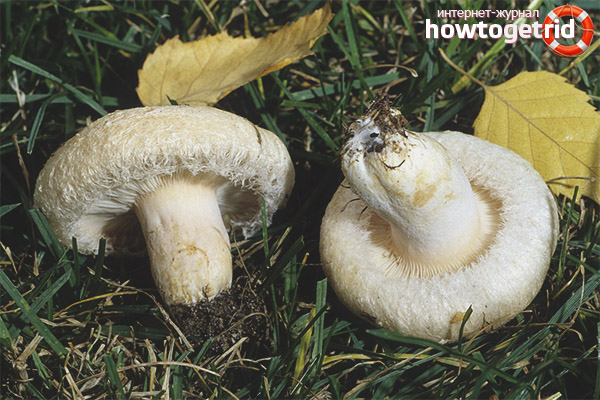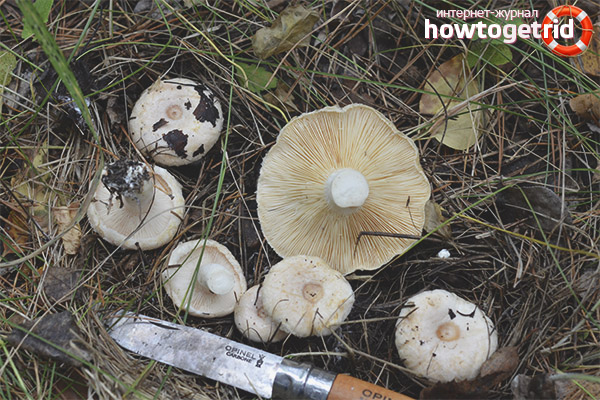The content of the article
For the white throat, or fluffy whitewash, a place in the classification of mushrooms is reserved for the family of russula, genus lactarius. For a snow-white outfit, it is also called a whitish. Having carefully studied the description of this fungus and only once having seen it, you will no longer confuse it with another.
What does a white wave look like?
The surface of the cap is fleecy, especially around the edges. Its diameter can be from 4 to 8 cm, but larger specimens are found, although rarely enough, in which the diameter reaches 12 cm. In the center, the hat is depressed, and the edges are tucked until the mushroom is young. Then they turn around. If it grows in open space, it most often has a funnel shape.
The color on the hat depends on in what area the mushroom grows, it acquires from a snow-white hue to pink, but regardless of color, always the most central part will be noticeably darker. Concentric zones are not very pronounced, however, you can see soft blurry yellowish-red circles resembling spots. You can find out that the mushroom is old by examining the hat: it acquires a yellow hue.
The pubescent skin is slightly rough to the touch. During rainy weather, it immediately becomes covered with slippery mucus.
The pulp of a white wave is dense, but rather brittle, white, with a lavish, plentiful, pungent juice, which is also white, does not change its color in the air. The pulp itself smells very nice, has a sweetish flavor.
The leg of the white wave is flat, has the correct cylindrical shape. It is narrowed to the bottom, especially if the mushroom grows in the grass. Pretty smooth to the touch, it is also slightly pubescent. Growing up, the leg of the fungus becomes more and more cellular, then hollow, unlike young ones with a whole leg, and in color it becomes the same with a hat.
If the mushroom grows:
- In open space - his leg is quite short, 2-4 cm tall.
- In thick grass - the height of the legs increases markedly, can even reach 8 centimeters long.
Leg thickness - 1-2 cm.
Habitat areas
Especially often, white thunderfish can be found in deciduous or mixed forests. She likes to sit near birches, especially very young ones, because mushroom pickers are looking for these mushrooms at the edges of birch groves and in coniferous-birch forest plantations. These mushrooms grow well in open, bright and dry places.
Begin to bear fruit in early August, their collection ends in late October, but it all depends on weather conditions. Usually mushrooms are harvested in stages, at first the crop can be harvested in August, and then in late September - early October.
The whitewash grows in the northwestern and central regions of Russia, as well as in Siberia and the Urals, the North Caucasus.
Composition
These mushrooms contain all the vitamins that support health: A, B, C. There are amino acids here, for example, leucine, threonine and others. This mushroom contains a lot of fiber.
Can I eat and how to cook?
If you listen to the opinion of mycologists, you can find out that they consider this mushroom to be slightly poisonous. The bitterness contained in the pulp is to blame. Therefore, it is necessary to soak the white wave for a long time and boil for a long time.If these conditions are not met, then, even being in the marinade, after six months, they will remain bitterness.
Western chefs consider this mushroom to be completely unsuitable for food, and in Russia it is readily salted and pickled, and even fried.
But before pickling, mushrooms must be thoroughly soaked or blanched in order to prevent further irritation of the gastric mucosa. Soak should be in cold water for at least three days, and the salting process takes up to 50 days. If all the preparations are done correctly, the dish turns out to be tasty, tender and mouth-watering. When all conditions are not met, the product will be spoiled due to the remaining bitterness.
White wave was decided to be classified by category II in taste and consumer qualities, that is, it is believed that it is a good quality mushroom. But mushroom pickers, if the year is fruitful for other mushrooms, most often do not pay attention to the whitewash. Many are scared away by bitterness in the pulp. But it is this property that helps the fungus protect itself from voracious mushroom worms, from which other mushrooms cannot be saved. This mushroom has no doubles inedible and poisonous.
Video: white thresher (Lactarius pubescens)











Submit